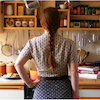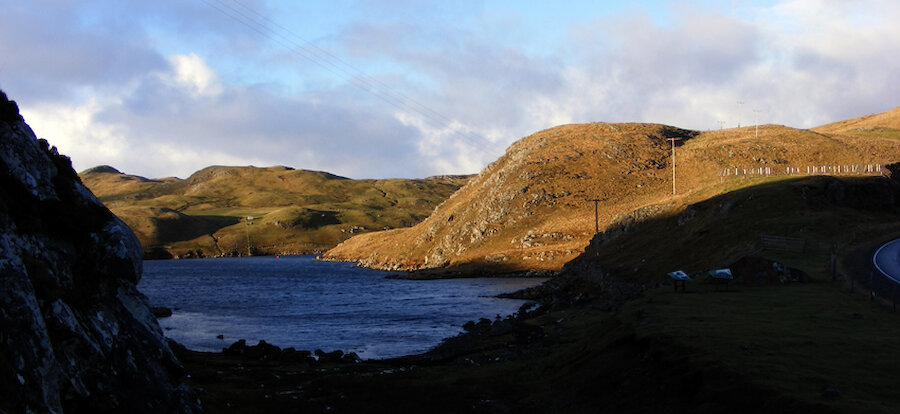In addition to a wide variety of other talents, Peter Sinclair of Hillswick makes excellent Shetland bannocks. I first heard of Mr. Sinclair through The Shetland Times newspaper last December when Maree Hay wrote about his bannock making skills in her regular column North Mainland Notes. Peter had been asked to teach a small class in Northmavine so others could learn to make his wonderfully light, fluffy and flavoursome Shetland bannocks at home.
I quickly tracked him down and asked (begged!) if he would teach me how to make them too, and much to my delight he agreed. So, one cool, crisp sunny morning I headed north past Mavis Grind, the narrow isthmus joining the Northmavine peninsula to the mainland of Shetland. It is said that a strong arm could throw a stone from the North Sea into the Atlantic here. It's a magical place, in my imagination, and since I don't come this far north very often passing this point always means adventure to me.
Peter welcomed me into his home with a friendly smile and I took an instant liking to him. He's quite the charming man with plenty of adventure stories to tell, plus, he can cook!
Peter was born and raised in Shetland and he recalls his grandmother making brönnies (round, thick oatmeal scones) with an extraordinary quantity of pork fat. Over the years he's perfected his own Shetland bannock recipe which have gained quite a reputation up north. He is often asked to make them for friends and family.
The key to making successful Shetland bannocks, Peter says, is to start with the right ingredients. Self-raising flour from the Johnson & Woods bakery in Voe, Shetland, must be used as results will not be the same with any other flour, he claims.
I spoke with the owners of the Voe Bakery and they say that their self-raising flour is blended with fresh flour direct from the millers and a raising agent in a ratio they've discovered from years of experience works very well.
Shetland Farm Dairies buttermilk is included and of course, a local Shetland hens egg.
There is some debate amongst bannock makers with regards to handling and kneading the dough. Some believe the dough should be handled as little as possible, but Peter reckons that it is his overworking the dough which contributes to a good bannock texture. He found, with experience, that the last batch of bannocks always turned out better than the first, and he attributes that to the extra kneading involved when you mix the remaining ends together.
Kneading involves folding the dough in half over and over again, adding just enough flour to make it not sticky. He uses a 2.5 inch square cutter so that there is no need to re-roll the ends. Peter insists that using buttermilk which is just about to go off improves the flavour of the bannock, as does the use of sharp natural yogurt. Peter makes his own yogurt for this very reason.
Shetland bannocks are superb warm, dripping with butter and home made rhubarb jam (as Peter and I ate ours), or served with thickly sliced salt beef, reestit mutton soup or just on their own. Peter bakes his bannocks in the oven, but you could also do them on the hob over a moderate heat, just flatten them so that they are thinner first and keep a close eye on them while they cook.
A final word from Peter: "Please share this recipe! The more people who share it the less I will have make!"
Enjoy!
Peter Sinclair's Shetland Bannocks
Course: Main
Servings: 20 bannocks
Prep Time: 10 minutes
Cook Time: 12 minutes
Ingredients:
- Voe bakery self raising flour - 20 oz
- Stork - 2 oz (or butter/margarine if you prefer)
- Caster sugar - 1 oz
- Shetland Dairies buttermilk - 284 ml
- Shetland hen's egg - 1
- Plain natural yogurt - 250-300 grams
Instructions:
- Preheat oven to 160°C (fan oven)/gas mark 6 and flour a baking tray.
- Combine flour and butter into a bowl and rub together with your fingertips until the mixture resembles coarse breadcrumbs.
- Add the sugar, buttermilk, egg and enough natural yogurt to make a sticky dough.
- Turn the dough out onto a floured board and knead, adding enough flour just until the dough is no longer sticky, but it is still light.
- Using floured hands gently press the dough down to a thickness of one inch.
- Cut with a biscuit cutter and place slightly spread apart on the floured baking tray.
- Bake for 12 minutes until well risen and golden on the top.
- Transfer to a wire baking rack to cool (if you can wait that long!)
Bannocks can be cooked on the stove top if you prefer, simply press your dough out slightly thinner, cut and cook on both sides over a moderate heat until browned and well-risen.





